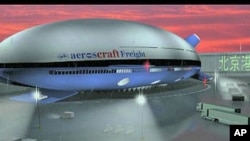A California company is developing a new type of airship for transporting cargo and, possibly, passengers. It is not an airplane and not a blimp, but has elements of both. The vehicle uses new technology and has commercial and military applications.
The new flying ship from the Aeros Corporation is called an Aeroscraft, and is designed to carry more than 50 tons of cargo and make deliveries thousands of kilometers away.
A demonstration model is being built outside Los Angeles, with funding from the U.S. Defense Department. It's in a hangar the Navy once used for its helium-gas-filled surveillance blimps. The test vehicle is 75 meters long and 30 meters wide, and should be ready to fly late next year.
Edward Pevzner of Aeros says it will get to hard-to-reach places.
"[This vehicle is ideal for] the north of Canada, Alaska, where big oil and gas exploration is going on, same as the Amazon region, or the continent of Africa, which is very poorly developed," said Pevzner.
Aeronautical engineer Tim Kenny says the key to the system is a new technology that allows the craft to go up or down without removing or adding weight, as is required on conventional airships. Unlike blimps, this craft requires no ground crew. And unlike blimps, it is not always lighter than air. Kenny says it is sometimes lighter and sometimes heavier than the air around it.
"The whole shape will be filled with helium throughout the whole vehicle, and then internal to that, we'll have the variable buoyancy system," Kenny explained.
The helium provides lift for the craft to go up, and when the helium is compressed, the craft loses its buoyancy and can land. Control and propulsion are provided by propeller-engines powered by aviation fuel. Kenny says the craft's light weight and rigid structure are made possible by new technology.
"Advancements in composites have really motivated and moved this industry a lot farther along," Kenny noted. "They're able to combine composites to aluminum and build lightweight structural components."
The demonstration model should fly by late next year. If it works as planned, even bigger versions may be on the market in a few years.
The U.S. military is interested in the ship's potential. So is industry. Commercial applications include moving turbines to hard-to-reach wind farms that generate electric power. The company says once the ships have proved their mettle hauling cargo, modified versions could also be built to ferry passengers.










